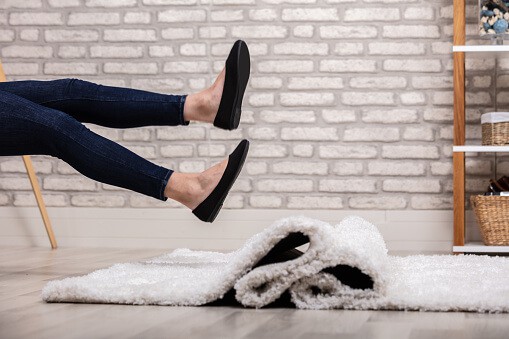You have researched the best rugs you can buy, and now you have the rug of your choice in your living room or bedroom. Everything looks great except that the rug keeps sliding and it is now turning into a liability.
Slipping rugs is hideous and extremely unsafe. An unforeseen slip underfoot could send you plummeting to the floor, leading to severe injuries.
Rugs help bring style in the room as well as offer warmth and cozy underneath your feet; however, without something to hold them into place; they may not be worth it. You can try cleaning the rug as well as sweeping underneath it but you can still find that not to do the job.
So how do you prevent your rugs from slipping?
Table of Contents
There are several tricks to help you keep your rug in place. Here are some of them:
Buy quality rugs
There are instances where an inexpensive carpet may be a good idea. For example, a rug to place under your dining table to avoid spills from damaging your larger rug shouldn’t be that expensive. However, when it comes to the main rug, going cheap may be more trouble than they are worth.
This is because cheap rugs tend to be lower quality and lighter compared to expensive, heavier rugs. And heavy rugs are less likely to slide. So if the cost is not a problem, a quality rug could solve this problem. Another reason for spending a bit more money on a rug is the reduced risk of toxins for babies and children.
Use anti-slip mats
One way to stop your rug from moving is by using another cloth between your carpet and area rug. Choose a beautiful looking mat that suits your style. The best option is a thick mat, which not only will it provide friction but also some cushion to wooden floors. Thin mats can also do the job correctly. It all depends on your taste and preferences.
However, when getting an anti-slip mat, make sure you go for the specialized carpet-to-carpet types, which are made from polyester materials. These types of mats will do more than just preventing your rug from sliding. They will also keep your rug safe and free from damages.
Alternatively, you can use rubber mats, but these are not as long-lasting as the other anti-slip mats, and so, you will need to replace them frequently. Also rotting rubber will ultimately become sticky and leave some marks on your rug.
Try anchoring it
This method requires using your furniture cleverly to hold your area rug into place. Though it may not be a glamorous way of preventing your rug from sliding, it can still do the job nicely and on top of it, bring your room together with its unmatched design element. Some of the furniture you can use for this purpose includes couches, buffets, coffee tables, dressers, and beds, among others.
Don’t be afraid to get creative with your arrangement. For example, you can allow some furniture pieces to overlap a little bit.
You will still need anti-slip mats or sticky tape for this method, but you will not use a lot of them.
Sticky tape
Most rug retailers tend to sell their products along with a double-sided sticky tape. Use that tape along the perimeter of the area rug, an inch or so from the edge as well as a few bands at the center for added security. If appropriately applied, the tape will stick together both the rug and the carpet and prevent sliding.
Another advantage of using sticky tape to hold your rug into place is that it also gathers dust, dirt, and debris. And while this is a good thing, it will lose its adhesive properties over time. Thankfully, you can replace it.
But it would help if you were cautious when using tapes to stick your area rug to place. I recommend using only tapes that are designed specifically for attaching rugs or at least the ones that do not have strong adhesive. This is because more durable tapes may leave markings behind when removed, staining your rug in the process.
If you have an expensive rug, it may be wise to avoid using tape.
Plug it
If you are using an inexpensive area rug, you can caulk it to prevent it from slipping. To do this, apply some droplets of silicone caulk underneath the rug. Apply some along the perimeter and in the middle of the rug.
Before it dries, flatten the droplets using a putty knife to spread the substance and enhance adhesion between the rug and the caulk.
Once the caulk is dry, position the rug over the carpet, and you are good to go. The dried caulk will hold the rug into place and prevent it from moving.
